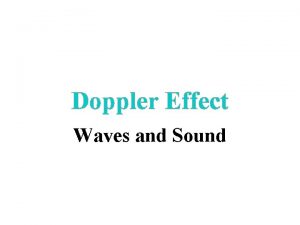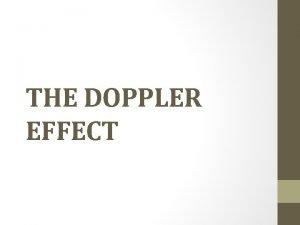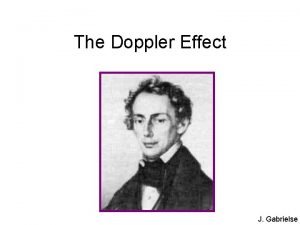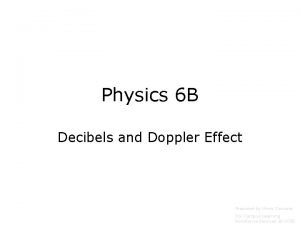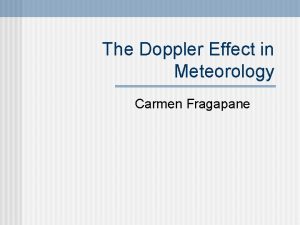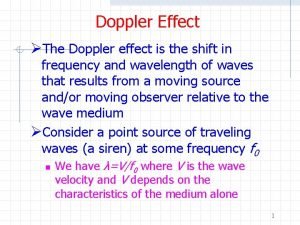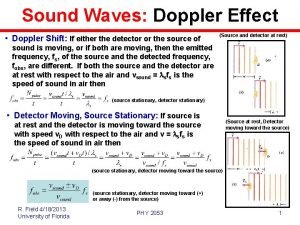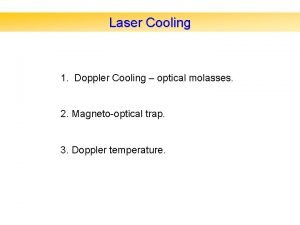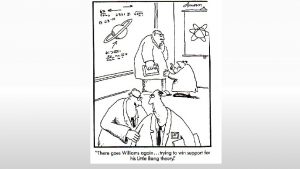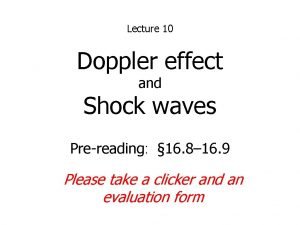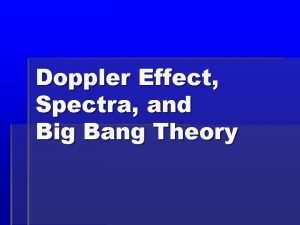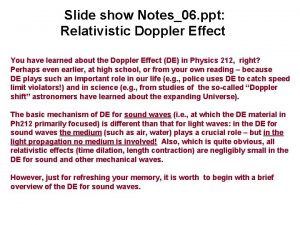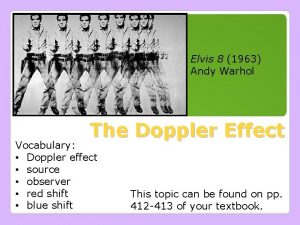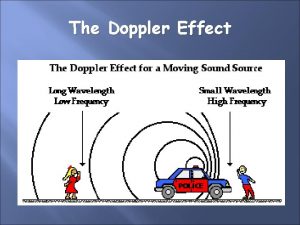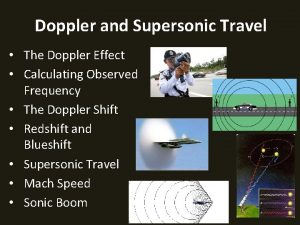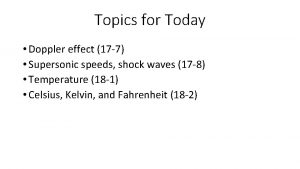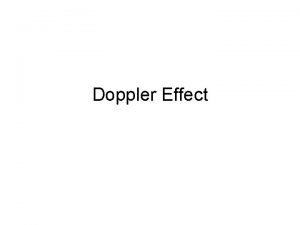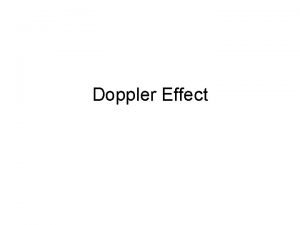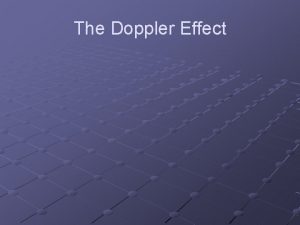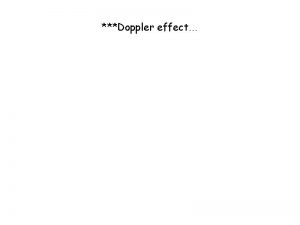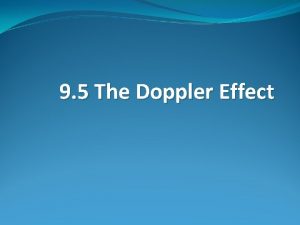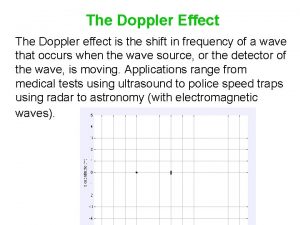Topics for Today Doppler effect 17 7 Supersonic















- Slides: 15

Topics for Today • Doppler effect (17 -7) • Supersonic speeds, shock waves (17 -8) • Temperature (18 -1) • Celsius, Kelvin, and Fahrenheit (18 -2)

Doppler Effect • Do demo 3 B 40. 10 - Doppler Effect - Buzzer and String • Sound waves from a stationary source expand out equally in all directions.

Doppler Effect

Doppler Effect A child is swinging back and forth with a constant period and amplitude. Somewhere in front of the child, a stationary horn is emitting a constant tone of frequency f. S. Five points are labeled in the drawing to indicate positions along the arc as the child swings. At which position(s) will the child hear the lowest frequency for the sound from the whistle? a) b) c) d) e) at B when moving toward A at B when moving toward C at C when moving toward B at C when moving toward D at both A and D

Supersonic Speeds What happens when the source moves faster than the speed of sound?

Supersonic Speeds and Shock Waves What happens when the source moves faster than the speed of sound? Do bull whip demo.

Supersonic Speeds 17 -8 Supersonic Speeds, Shock Waves

Sources of Musical Sound Which one of the following statements explains why a trombone and a didgeridoo playing the same musical note sound different? A) The fundamental frequency is different for each instrument. B) The two instruments have the same fundamental frequency, but different harmonic frequencies. C) The two instruments have the same harmonic frequencies, but different fundamental frequencies. D) The two instruments have the same fundamental frequency and the same harmonic frequencies, but the amounts of each of the harmonics is different for the two instruments.

17 -8 Supersonic Speeds, Shock Waves Thermodynamics • Is the study of how heat moves between objects and affects their properties. • One of the first applications was to calculate the efficiency of steam engines. • Heat is energy at the atomic/molecular level.

Temperature 17 -8 Supersonic Speeds, Shock Waves • Temperature determines which way heat flows between two system that are in contact. • Heat flows from the system at higher temperature to the one at lower temperature. • If the two systems have the same temperature, then they are in “thermal equilibrium”, meaning there is no net transfer of heat between them. • Zeroth law of thermodynamics – if system A is in equilibrium with system B and system C, then system B is in equilibrium with system C.

Temperature 17 -8 Supersonic Speeds, Shock Waves • Temperature is a measure of motion at the atomic/molecular level. • Higher temperatures correspond to higher kinetic energies, lower temperatures correspond to lower kinetic energies. • This naturally leads to a zero of the temperature scale, when the kinetic energy is zero. • The Kelvin scale is defined to be zero at “absolute zero”, which means the kinetic energy due to heat is zero.

17 -8 Supersonic Speeds, Shock Waves Temperature • The Kelvin scale is defined to be 273. 16 K at the “triple point” of water. • The triple point is where you can have liquid water, solid ice, and water vapor all at once. • It is very close to the freezing point of water at one atmosphere of pressure.

Temperature 17 -8 Supersonic Speeds, Shock Waves

Interference Two identical speakers are emitting a constant tone that has a wavelength of 0. 50 m. Speaker A is located to the left of speaker B. Where should you put your ear to hear silence (complete destructive interference occur)? A) 2. 00 m from speaker A and 3. 00 m from speaker B B) 2. 50 m from speaker A and 1. 00 m from speaker B C) 2. 15 m from speaker A and 3. 00 m from speaker B D) 3. 75 m from speaker A and 2. 50 m from speaker B

Speed of Sound Earthquakes generate sound waves inside Earth. Unlike a gas, Earth can experience both transverse (S) and longitudinal (P) sound waves. Typically, the speed of S waves is about 4. 36 km/s, and that of P waves 8. 06 km/s. A seismograph records P and S waves from an earthquake. The first P waves arrive 263 seconds before the first S waves. If the waves travel in a straight line, how far away does the earthquake occur? A) 973 km B) 1147 km C) 2120 km D) 2498 km
 Supersonic flow
Supersonic flow Doppler effect formula
Doppler effect formula Doppler effect when to add or subtract
Doppler effect when to add or subtract Doppler effect quiz
Doppler effect quiz Decibel equation
Decibel equation Doppler effect in meteorology
Doppler effect in meteorology Doppler effect in light
Doppler effect in light Doppler effect
Doppler effect Optical molasses
Optical molasses Doppler effect bbc bitesize
Doppler effect bbc bitesize Doppler effect
Doppler effect Doppler effect
Doppler effect Doppler effect big bang
Doppler effect big bang Doppler effect animation ppt
Doppler effect animation ppt Doppler effect
Doppler effect Doppler effect
Doppler effect

